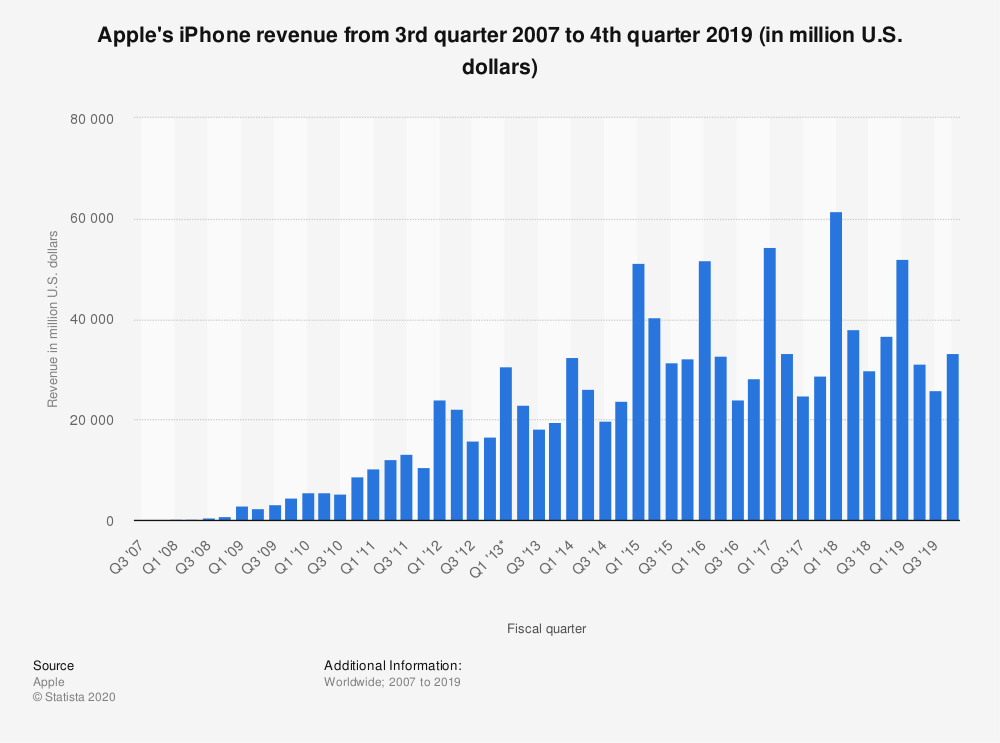A recent change in Apple product sales guidance sent temporary shockwaves through the market.
On the day it said it would not make its next quarterly guidance because of the coronavirus outbreak in China, two of the three major U.S. indices dropped.
However, there is one thing that can save Apple Inc. (Nasdaq: AAPL) from the potential for lower-than-expected future sales: the introduction of a new 5G-compatible iPhone, which was supposed to hit store shelves this September.
The biggest question is whether the product will even come to the market this year.
Apple’s Chinese Production
The spread of the coronavirus has taken a toll on Apple as it relies heavily on production in China. Its guidance withdraw is evidence of that.
Apple’s Chinese manufacturing partner, Foxconn Technology Group, has manufacturing facilities in Chengdu and Shenzhen.
Those facilities can produce up to 6,000 units — iPhone and iPad — per day and employ nearly 350,000 workers.
Apple’s use of Chinese plants to mass-produce its products comes down to the fact that those facilities can meet the company’s demand faster.
Nearly 75% of Apple’s suppliers have at least one production facility in China while 22% have three or more there.
Apple’s Sales Problem
Apple said the biggest reason for withdrawing guidance was because of slumping demand for its products in China and a lower supply of its massively popular iPhone.
The biggest concern is that it’s still unknown just how the coronavirus will impact global markets — or how long that impact will last.
“The market is taking it in stride, meaning that they know that this virus is going to have an impact on the supply chain but the severity of the impact is still unclear,” U.S. Bank Wealth Management investment strategist Jeff Kravetz said. “But investors are not overly concerned and we’re higher this year just because we’ve got an accommodative Fed, higher earnings and — when you exclude the impact of the virus — an incredibly resilient consumer.”
Its original guidance was $63 billion to $67 billion, but CEO Tim Cook said that it was too wide so the company withdrew its guidance completely.
Since the overall impact of the coronavirus remains to be seen, so does its impact on companies like Apple, who rely so heavily on China for both product sales and production.
Apple’s Saving Grace
There is one thing that could help Apple reverse the potential for a drop in sales.
With the slow rollout of 5G networks around the world, smartphone makers are rushing to push 5G-compatible phones to market.
A release of a 5G iPhone model would drive a considerable amount of customers to upgrade to the new model.
When 4G technology was rolled out globally in 2010, Apple product sales and revenue nearly doubled to more than $8 billion by the fourth quarter that year.
Apple’s revenue usually jumps in the first quarter following a new iPhone announcement. So, you can see that new phones equal huge revenue.

It is safe to assume that when Apple launches a new 5G-compatible iPhone, its sales will jump through the roof.
The Biggest Issue
Because of the unknown impacts the coronavirus will have on Chinese production, Apple may not be able to release a new 5G iPhone in September, as expected.
It is also likely to miss its target date for releasing a new, cheaper version of the iPhone S — scheduled for a spring 2020 ship — according to Nikkei Asian Review.
“On average, suppliers in the iPhone supply chain are currently operating at around 30% to 50% of capacity,” an unnamed source told Nikkei. “The constrained supply of iPhones will likely extend to April. There are still a lot of hurdles, from labor shortages to logistics transportation.”
So while a 5G iPhone can help Apple meet — or even beat — product sales forecasts, delays in production due to the coronavirus will likely push back when consumers can rush to buy the new phone.





